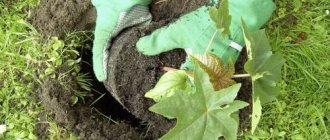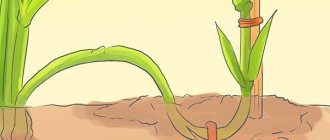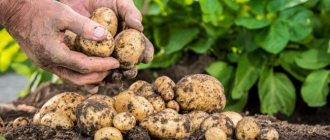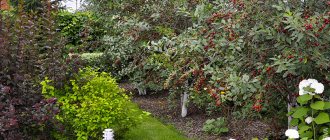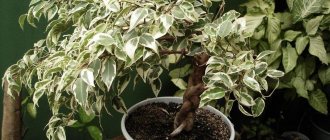When is the best time to replant a spruce?
In order for a young tree from the forest to take root safely, you need to choose the right time for transplantation. The success of rooting in a new place depends on the processes occurring in the root system.
The roots begin to grow rapidly in the spring, and the growing season is completed by the end of summer and beginning of autumn. It is ideal to replant the tree in early April, when the soil has already thawed, but intensive growth has not yet begun, and in mid-August.
Important! Trees with a height of 3 meters and above can only be replanted in the winter months, with a frozen ball of soil around the root.
Step-by-step plan for planting spruce
The process of planting spruce is divided into several stages. First of all, the planting hole is prepared, which involves digging a hole of a suitable size. If the substrate is completely changed, the side walls must be covered with enclosing material that allows moisture and air to pass through, but maintains the level of mineral content. The shape of the hole is more like a large flower pot. Gardeners often isolate it with a pine or spruce slab.
Next, the process of optimizing the soil mixture begins. You can implement it yourself by mixing the necessary components, or buy it at a gardening store. The second option is more in demand due to its simplicity and accessibility. The selected substrate is introduced into the prepared pit, after which it is compacted for 2 weeks.
The next stage involves treating the root system with a solution of Kornevin, succinic acid, Radifarm and other stimulants. The seedling is planted in such a way that the neck of the roots is located at the same level as the edge of the hole. Then the lump is covered with soil.
In order to form a tree trunk circle, a roller of soil is laid out near the crown. The last stage is to water the seedlings. For small plants, 2-3 buckets are enough, and for large plants - 4-5.
If you need to figure out how to grow spruce from seeds, you can follow similar instructions, but carefully process the seed material in order to increase germination. Before planting in open ground, the seeds are soaked for 3 days in warm water until they swell. To stimulate root growth, they can be treated with a special solution.
The remaining subtleties of planting and caring for spruce trees involve seasonal pruning, watering and the application of mineral fertilizers.
How to choose a good tree
In order for a plant to adapt without problems to a summer cottage, you need to choose the right seedling. The spruce must be young, strong and healthy. The experience of foresters confirms that free-standing trees grown on the edge of a forest, a clearing, or the side of a road, as a rule, have stronger immunity and take root well in a summer cottage.
Young specimens, 50–100 cm high, with evenly growing symmetrical branches, healthy needles and trunk, are best suited for planting in the country. It is necessary to carefully inspect the plant for damage and check whether it has any serious defects.
Preparing a new place
Not all areas are suitable for productive cultivation of blue spruce, so when selecting a specific place for replanting it, you should take into account the location in the natural growing environment from which the tree was removed (when purchasing seedlings in a private nursery, all important information can be clarified with the owner).
The best option would be a well-lit place, but protected from direct sunlight , at least ten meters from residential buildings or other buildings. The appropriate level of groundwater is at least two meters from the soil surface, which will eliminate the possibility of waterlogging and stagnation of moisture at the root system of plants.
Having decided on the site, dig a hole suitable for the tree, focusing on the size of the seedling’s earthen ball. At the bottom of the hole you need to pour a mixture of sand, sawdust, pine needles collected from the forest and acidic mineral fertilizers. True, the latter should be added to the substrate only if it is not acidic enough.
Granite pebbles or broken bricks are used as a drainage layer, but instead of laying them out in a separate layer, it is better to mix everything with soil, simultaneously adding a little soil from their former spruce growing area.
Before planting, you can slightly moisten the prepared substrate, and then loosen it and organize a small hill on which the tree will be placed. If the earthen ball is dense and approximately evenly cylindrical in shape, you can do without a mound by placing the plant on the leveled surface of the planting hole.
If you are planning to transplant several trees at once, you should leave at least 3 m of free space between them , and then only if another transplant is planned in the future. Mature trees have a highly developed rhizome, so they can interfere with each other, until growth stops, and to prevent this from happening, it is advisable to increase the distance between small seedlings to 5–10 meters.
What is needed to transplant a tree
In order for the spruce transplant to take place correctly and easily, you need to prepare.
The process will require:
- garden shovel;
- a piece of cotton fabric measuring 1 m² to wrap the root;
- colored tape for marks on the tree trunk;
- canister of water (10 l);
- a large bag or bag for soil;
- rope to tie the seedling during transportation.
It is better to dig a hole on the site in advance, so that after transportation the tree can be planted immediately.
Did you know? In the Komi Republic, a unique multi-trunked spruce grows; according to preliminary estimates, 11 trunks grow from one root.
Digging process
When a coniferous beauty has been selected for transplantation, you can start digging it up. Care must be taken during the process to avoid damaging the tree.
Extraction involves several steps:
- You need to water the plant at the root to soften the soil and make digging easier. After watering, you need to wait at least half an hour for the water to be absorbed.
- In parallel with the previous stage, it is necessary to apply markings to the trunk of the tree using a small piece of electrical tape or colored tape: you need to mark which side of the trunk faces south and which faces north. This is necessary in order to plant a tree in the dacha in the same way as it was located in natural conditions.
- Mark the area around the trunk, stepping back 50–70 cm from it. This can be done with a shovel, digging a small hole in a circle. If the height of the tree is higher than 1 meter, then the indentation should be greater, at least 1 meter.
- Gradually deepening the dug ditch, remove the plant from the soil along with a large earthen lump, carefully lift it and place the fabric prepared in advance under it. Wrap the root and tie its ends. The tree is now ready to be transported to a new location.
Important! Young spruce adapts better to new conditions if you take a little soil from its habitat and add it to the hole when planting it on the site. It is recommended to remove the top, most fertile layer.
Transplanting an adult spruce. Replanting spruce
Spruce is a frost-resistant, evergreen tree with a shallow root system, undemanding to growing conditions and resistant to air pollution. Grows well on sandy loam and loam, does not like close groundwater. It loves bright, diffused light, so it fits perfectly with birch plantations.
It can reach a height of 40 m. The roots spread 15 - 20 m from the trunk, so you should not plant the spruce closer than 20 m from the house or on a small plot of land. Since the root system of spruce is superficial, it is prone to windfall, and this is a real threat to the house.
Spruce grows very slowly, and if you want to quickly green up the area, you can transplant mature trees (up to 15 m in height) to permanent locations. The best time to transplant large trees is the beginning of winter, when the ground is quite frozen, but the air temperature is not lower than minus 8 - 12 °C. At lower temperatures, spruce roots may freeze. You can replant spruce trees at the very end of winter, while the soil has not yet thawed. In both cases, when digging up trees, the frozen soil adheres well to their roots, and the roots are minimally damaged.
For transplantation, choose a healthy spruce without visible damage. In the spring, a trench about 1 m deep and 20–30 cm wide is dug along the perimeter of the crown, cutting off the roots of the spruce with a shovel. Peat or humus is poured into the trench, and fertilizers are added to stimulate root formation. The poured soil is well shed; Watering is repeated several times during the summer, especially during the dry period. By autumn, many thin roots will form in the trench.
A planting hole with steep walls is dug in the fall; the earth from it is placed in the basement so that it remains soft. They also store sand, 2–3 buckets of bedding from under spruce trees and dry fallen leaves. The diameter of the planting hole should be 1 m larger than the diameter of the crown; The depth of the hole is about 1 m. A tall spruce is dug up with a rooter: it holds both the roots with the ground and the crown without damaging them.
You can dig a tree up to 2 m tall yourself by digging it along the outer radius of the trench and cutting off the remaining roots. The depth to which the roots of a tree of this height go is no more than 60 cm. Having tilted the spruce strongly, the earthen lump with roots is watered, and it becomes covered with a crust of ice. When transporting spruce, this will protect the soil from weathering and the roots from drying out. Then, burlap is placed under the roots of the spruce, tied around the trunk and the seedling is transported to the planting site.
Before planting, forest litter, a little sand and dry leaves are poured into the bottom of the hole. The seedling is installed so that the root collar is 5–7 cm above the ground level: when the ground settles, the tree will fall into place. The space between the walls of the pit and the earthen lump with roots is covered with soft earth and compacted. 3-4 strong stakes are driven along the edge of the planting hole, and the spruce is tied to them so that it does not fall from the wind. The tree trunk circle is well covered with peat, humus, fallen leaves, and spruce branches. It is important to maintain the orientation of the tree in the north-south direction when replanting.
Transporting wood
To safely deliver the dug spruce to your personal plot, you need to follow simple rules for transporting seedlings:
- preserve the earthen lump and ensure its integrity using damp, breathable fabric (cotton, burlap);
- tie the branches of the plant with a rope, slightly pulling them towards the trunk to avoid damage;
- transport on a horizontal or inclined surface so as not to damage the trunk;
- transport as quickly as possible so that the tree loses a minimum of nutrients.
Selection of a place for transplantation
Perhaps the most crucial moment is choosing a place in the garden where the forest spruce will be planted. Before deciding where the tree will look beautiful and appropriate, you need to familiarize yourself with the basic rules of agricultural technology.
Coniferous trees are very unpretentious to the composition of the soil. They grow best on sandy soil, but they feel quite good in both black soil and loam. The most important requirement is good drainage, since stagnation of water is detrimental to spruce roots.
Rules for caring for seedlings
When growing spruce, it is important not to forget about it; seedlings are especially sensitive and need care.
To prevent them from dying, it is recommended:
- Pour at least 10 liters per week under one tree;
- Systematically loosen the soil and spray with a hose, washing away the dust;
- Do not apply too much fertilizer; spring feeding will be sufficient;
- Systematically remove dry branches; if the top begins to bifurcate, remove one of the shoots.
Proper care of a young seedling is the key to growing a beautiful and strong tree. It requires some effort, but the beauty of a well-groomed conifer is worth it.
Planting process
So, the place has been chosen, then another serious task follows: replanting the plant, providing it with optimal conditions for growth.
It was already mentioned above that the planting hole must be prepared in advance. Usually, for young trees, a hole with a diameter of 70 cm and the same depth is dug, drainage is poured into the bottom and a little water is poured so that the soil softens.
Find out how long a spruce tree lives.
The brought seedling, along with the burlap with which it is tied, is placed in a hole and sprinkled with earth. After installing the root, the fabric must be untied and left in the soil: over time, it will naturally disintegrate, but for now it will maintain the usual environment for the roots. Along with the soil, soil brought from the forest is poured into the hole.
After planting, the tree is watered, the trunk circle is mulched with pine needles (in its absence, ordinary sawdust can be used). Watering in the first weeks, while the tree is taking root, is carried out regularly, without waiting for the soil to dry out, pouring 10 liters of water under one plant. It is important to consider that you need to water the spruce not at the base of the trunk, but in a circle, at a distance of 30–40 cm from it.
Video: Transplanting spruce from the forest to the site
How to transplant a Christmas tree from the forest into a pot. How to plant a Christmas tree from the forest
It is not always possible to buy spruce; sometimes it is dug up in the forest, but in order for such a tree to grow on the site, it is important to choose the right plant. So, trees on the outskirts of the forest, which reach a height of one and a half meters, will be optimal.
In order for the tree to grow and develop normally, the transplantation process must obey a number of rules. If they are followed, problems will be minimized.
This is what is recommended:
- Under the selected tree, dig a circle along the diameter of the lower branches to a depth of half a meter.
- After this, you need to start carefully digging out the roots. At the same time, be sure to use ribbons to indicate where the tree was on the north side and where the south side was.
- The latter is especially important when planting, it helps reduce stress on the tree;
- After the tree is dug up, fill a bag with native spruce soil;
- When it is delivered to the site, begin preparing a hole, which should correspond in size to the earth;
- Be sure to pour forest soil native to the tree at the bottom of the hole;
- Carefully place the roots into the dug hole, make sure that the roots do not curl or break; if this happens, widen the edges of the hole;
- Make sure that the location of the branches corresponds to the south and north. Sprinkle the roots with the rest of the forest soil, moisten with fertilizer and water generously.
The main care of a young seedling consists of regular and abundant watering. The earth should not dry out, this can lead to its death.
